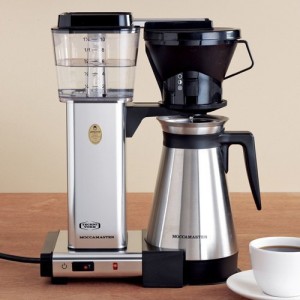There are plenty of methods to choose from when making your morning (or night time) coffee. It really comes down to how much work you want to put into it and then as your palate grows the mouth feel you like.
Electric Brewers are going to be easiest to use if you want a lot of coffee first thing in the morning. Jamie recommends one. There’s only one because it’s the only home coffee brewer that actually gets hot enough to brew coffee, meaning it brings the water above 200 degrees. Most electric brewers don’t. You want your water to be between 198 and 202 degrees. In order to get it there you need to boil your water, because by the time your boiling water hits the cold coffee it’s going to end up dropping and over the length of the four minute brew time it’s going to drop even more.
This Jamie approved electric brewer is called The Technivorm and it costs $300.
But he reminds everyone that even with a good electric brewer you still need a good grinder.
For manual methods you need to allow your four minutes of brew time. So, if you’re not willing to give that up in the morning this isn’t for you. Certain methods require more prep time so get to know what’s what and decide what’s best for your coffee routine.
Jamie says the Chemex is certainly the most beautiful method available.
“There’s a certain amount of class to the chemex.”
If you buy the correct size a Chemex can brew up to 12 cups of coffee. It takes more time than any other brew methods and more skill, but if you learn from the right person you’re good to go.
“As far as its aesthetic and the craft that goes into it, I think it’s one of the better methods to serve guests with.”
So, if you’re having a dinner party, consider having one on hand.
The easiest method to reproduce is the Clever. You can make up to 16 ounces with this method and the steps are limited.
And then there’s the method everyone already knows about, The French Press.
When I asked Jamie about this method he asked me if he could clear the air and I obliged.
“I do appreciate the convenience of the French press, but when you’re brewing with a French press, the only way to do it correctly is to finish pressing the coffee to the bottom of the pot at 4 minutes and to immediately empty the French press into a serving vessel,” said Jamie.
When you don’t do this the hot water continues to over extract the coffee. It continues to get sludgier and dirtier as well as bitterer and less palatable.
“I know a lot of people say they like that and I cannot tell them that they don’t like that, but I would urge them to try a properly extracted French press, one that isn’t burnt and bitter, and to decide whether or not that is better for themselves.”
Jamie’s next step is to point out how caffeine and tannins work. He says after four minutes your beans start to release the majority of its caffeine content. Caffeine is very bitter. But, if you’re properly brewing your coffee you won’t get that extra caffeine push because you won’t be brewing after four minutes. But, that’s also why you can always tell when a cup of coffee is extracted improperly, because the bitterness tells it all.
Tannins are also released at the end of the brewing cycle, which are bitter and actually harsh on your stomach. Jamie points out properly brewed coffee shouldn’t be harsh on anyone’s stomach. Nor should properly brewed coffee be unpleasant to drink.
“So, brewing it right is really better for your body as well as your palette.”
After all that, it’s clear that there’s a proper way to brew and drink a French press, it’s just not what most people are used to.
“Just do the world a favor and empty your French press and enjoy it that way.”
And while your’e doing that make sure to also get a few, inexpensive items for your manual methods: a filter, timer and spoon.
Filters vary from each brew method. Each will typically say on its packaging and will be for sale near the methods itself.
Timer: Any kitchen timer with minutes on it will do. I prefer to have seconds as well so I can see when the end of my brew cycle is coming.
A Spoon: stainless steel, bamboo or plastic will work. Just make sure if you continue to use that spoon for coffee, or anything else, that it doesn’t take on scents or tastes, because then you might accidentally have onion flavored coffee, and that sounds awful, now doesn’t it?
I hope you’ve enjoyed learning all about how to make coffee at home. I feel like there’s so much more to share, and there really is, but you have to tell me what it is you want.







Leave a comment